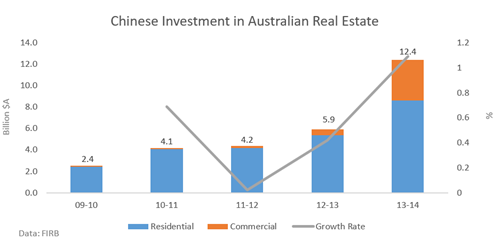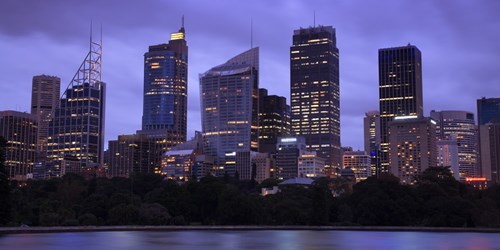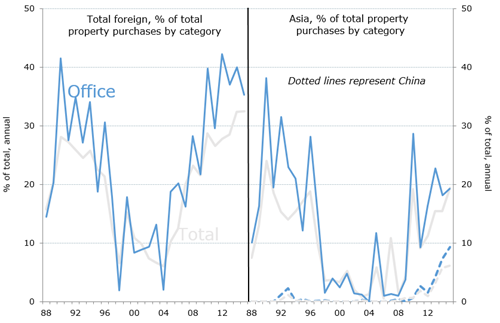-
Despite the high profile of Asian, and particularly Chinese, investors in Australian residential property recently they have been playing a stronger but much lower-key role in the commercial property market. Could Chinese investors be the hidden dragon driving the market higher?
Chinese investment in commercial real estate quadrupled to $A4.37 billion in 2014. Commercial real estate now accounts for 46 per cent of total Chinese investment in Australia and according to many experts, this trend is only set to continue as China's outbound investment grows.
"Chinese investment in commercial real estate quadrupled to $A4.37 billion in 2014."
Jerry Ge, BlueNotes contributorANZ's Caged Tiger report identified Chinese foreign direct investment (FDI) as a huge source of investment capital in the years ahead. Outward FDI is likely to increase substantially following China's capital account liberalisation and rise from around $US500 billion in 2012 representing 6 per cent of GDP to as high as $US9.5 trillion, representing 15 per cent to 35 per cent of GDP in 2030.
Between 2012-13 and 2013-14, approved investment in Australian commercial and residential property from China more than doubled, with China now providing around 20 per cent of all foreign investment in Australian property.
{CF_IMAGE}
Official data on foreign investment in Australian residential property remains patchy as highlighted in the 2014 Commonwealth Government Report on Foreign Investment in Residential Real Estate.
However foreign investment approvals data indicate that Chinese investors purchased around $A12 billion of Australian property in 2013-14, with a majority of this investment still in residential property.
The data on commercial property investment is also not conclusive but the weight of deals is becoming far more evident.
In the recent high-profile Investa Property Trust transaction, Chinese Investment Corporation (CIC) sealed a $A2.5 billion deal for nine premium office towers across Sydney, Melbourne and Brisbane.
This portfolio of assets, sold by Morgan Stanley Real Estate, includes Sydney CBD landmarks 126 Phillip Street, 225 George Street and 400 George Street, as well as 120 Collins Street in Melbourne and 410 Ann Street in Brisbane. The properties house notable blue chip tenants such as Rio Tinto, Telstra, Deloitte and Deutsche Bank.
{CF_IMAGE}
It is the biggest single direct real estate sale in the Australian market, making CIC the third biggest office landlord in Australia, behind DEXUS and GPT Group. Without a doubt, the appetite of Chinese investments in the Australian commercial real estate market is enormous.
“Strong demand for Australian commercial property has driven strong capital growth and yield compression, particularly for prime office and retail properties in the major capital cities, with only a subdued positive impact on commercial property construction," ANZ Research Senior Economist David Cannington said.
“In comparison to previous cycles of strong capital growth in Australian commercial property, this cycle has not been supported by strong leasing conditions with demand for commercial property space aligning with soft business confidence and conditions across the broader Australian economy.
"While this trend reflects the elevated and stable returns offered by Australian commercial property to investors, it also presents some downside risk to Australian commercial property capital values in the event of an unexpected shock to global capital financial markets."
A research report published by Knight Frank shows that portfolio diversification, relatively low funding cost and a transparent regulatory environment are a few reasons that attracts Chinese investors to the Australian commercial property market.
Consequently, Australian commercial property investors are keeping a close eye on China and other Asian financial markets.
{CF_IMAGE}
As foreign investment policy in Australia does not restrict foreign investment in new or proposed dwellings, Chinese investment has added significantly to the surge in new housing construction in recent years, particularly construction of new apartments in Sydney and Melbourne (and to a lesser extent Brisbane).
It is estimated that Chinese investments account for 18 per cent of new dwellings in Sydney and 14 per cent in Melbourne. In other major Australian cities, Chinese investments account for around 7 per cent or lower.
Despite media attention, foreign investment in residential real estate still only account for a small amount of the residential property market.
NAB's 2014 Residential Property Survey has shown that foreign investors only account for 14.8 per cent and 8.7 per sent respectively for new and established residential real estate in Australia.
Chinese investments taking an even smaller proportion of only 2.2 per cent of Australian annual residential real estate turnover of $A270.5 billion.
The views and opinions expressed in this communication are those of the author and may not necessarily state or reflect those of ANZ.
-
-
-
EDITOR'S PICKS
-
ANZ CEO Mike Smith has labelled global concerns over the economic health of China overblown and says the bank has no worries over its exposure to the Asian giant.
14 September 2015 -
Chinese tourists spent $US130 billion on their international travels last year – equivalent to the combined GDPs of the world's 50 smallest countries. Experts are predicting this armada of tourism dollars will almost double in just three years.
16 September 2015 -
Having lived and worked in Asia for a decade and a half, I'm very aware Australians do not adapt easily to the uniquely 'Asian Way' when it comes to business dealings. Asia is obviously different but uncomfortably so for many of those businesses with which I've worked.
1 October 2015



